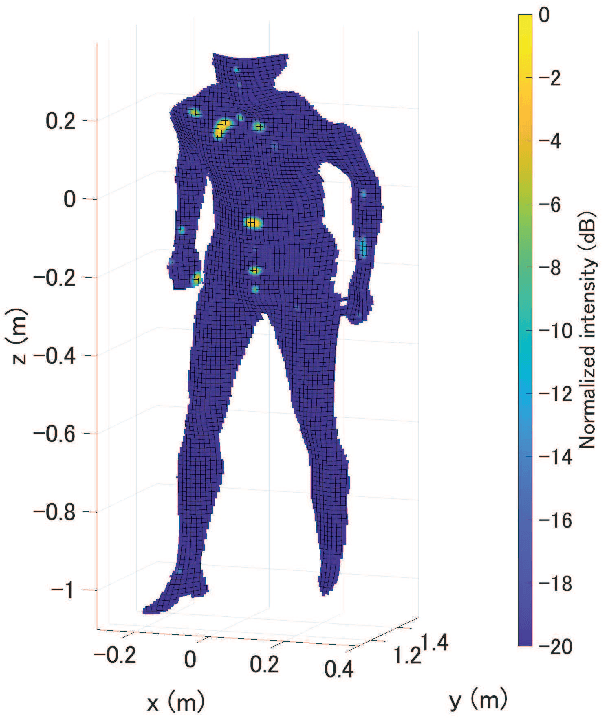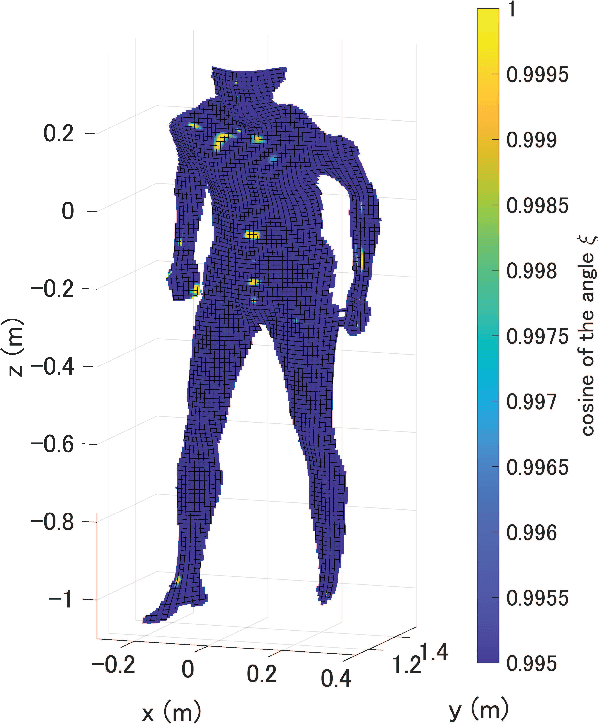Takuya Sakamoto
A Nonlinear Spectral Approach for Radar-Based Heartbeat Estimation via Autocorrelation of Higher Harmonics
Jul 28, 2025Abstract:This study presents a nonlinear signal processing method for accurate radar-based heartbeat interval estimation by exploiting the periodicity of higher-order harmonics inherent in heartbeat signals. Unlike conventional approaches that employ selective frequency filtering or track individual harmonics, the proposed method enhances the global periodic structure of the spectrum via nonlinear correlation processing. Specifically, smoothing and second-derivative operations are first applied to the radar displacement signal to suppress noise and accentuate higher-order heartbeat harmonics. Rather than isolating specific frequency components, we compute localized autocorrelations of the Fourier spectrum around the harmonic frequencies. The incoherent summation of these autocorrelations yields a pseudo-spectrum in which the fundamental heartbeat periodicity is distinctly emphasized. This nonlinear approach mitigates the effects of respiratory harmonics and noise, enabling robust interbeat interval estimation. Experiments with radar measurements from five participants demonstrate that the proposed method reduces root-mean-square error by 20% and improves the correlation coefficient by 0.20 relative to conventional techniques.
Accurate Radar-Based Detection of Sleep Apnea Using Overlapping Time-Interval Averaging
May 26, 2025Abstract:Radar-based respiratory measurement is a promising tool for the noncontact detection of sleep apnea. Our team has reported that apnea events can be accurately detected using the statistical characteristics of the amplitude of respiratory displacement. However, apnea and hypopnea events are often followed by irregular breathing, reducing the detection accuracy. This study proposes a new method to overcome this performance degradation by repeatedly applying the detection method to radar data sets corresponding to multiple overlapping time intervals. Averaging the detected classes over multiple time intervals gives an analog value between 0 and 1, which can be interpreted as the probability that there is an apnea event. We show that the proposed method can mitigate the effect of irregular breathing that occurs after apnea / hypopnea events, and its performance is confirmed by experimental data taken from seven patients.
Radar-based Measurement of the Body Movements of Multiple Students in Classroom Environments
Dec 03, 2024Abstract:We demonstrate the feasibility of the radar-based measurement of body movements in scenarios involving multiple students using a pair of 79-GHz millimeter-wave radar systems with array antennas. We quantify the body motion using the Doppler frequency calculated from radar echoes. The measurement accuracy is evaluated for two experimental scenarios, namely university students in an office and elementary school students in a classroom. The body movements measured using the two radar systems are compared to evaluate the repeatability and angle dependency of the measurement. Moreover, in the first scenario, we compare the radar-estimated body movement with subjective evaluation scores provided by two evaluators. In the first scenario, the coefficient of correlation between the radar-estimated body movement and the subjective evaluation score is 0.73 on average, with a maximum value of 0.97; in the second scenario, the average correlation coefficient of body movements measured using two radar systems is as high as 0.78. These results indicate that the proposed approach can be used to monitor the body movements of multiple students in realistic scenarios.
Individual Identification Using Radar-Measured Respiratory and Heartbeat Features
Aug 02, 2024



Abstract:This study proposes a method for radar-based identification of individuals using a combination of their respiratory and heartbeat features. In the proposed method, the target individual's respiratory features are extracted using the modified raised-cosine-waveform model and their heartbeat features are extracted using the mel-frequency cepstral analysis technique. To identify a suitable combination of features and a classifier, we compare the performances of nine methods based on various combinations of three feature vectors with three classifiers. The accuracy of the proposed method in performing individual identification is evaluated using a 79-GHz millimeter-wave radar system with an antenna array in two experimental scenarios and we demonstrate the importance of use of the combination of the respiratory and heartbeat features in achieving accurate identification of individuals. The proposed method achieves accuracy of 96.33% when applied to a five-day dataset of six participants and 99.39% when applied to a public one-day dataset of thirty participants.
Accurate Radar-Based Heartbeat Measurement Using Higher Harmonic Components
Jul 10, 2024



Abstract:This study proposes a radar-based heartbeat measurement method that uses the absolute value of the second derivative of the complex radar signal, rather than its phase, and the variational mode extraction method, which is a type of mode decomposition algorithm. We show that the proposed second-derivative-based approach can amplify the heartbeat component in radar signals effectively and also confirm that use of the variational mode extraction method represents an efficient way to emphasize the heartbeat component amplified via the second-derivative-based approach. We demonstrate estimation of the heart interbeat intervals using the proposed approach in combination with the topology method, which is an accurate interbeat interval estimation method. The performance of the proposed method is evaluated quantitatively using data obtained from eleven participants that were measured using a millimeter-wave radar system. When compared with conventional methods based on the phase of the complex radar signal, our proposed method can achieve higher accuracy when estimating the heart interbeat intervals; the correlation coefficient for the proposed method was increased by 0.20 and the root-mean-square error decreased by 23%.
Radar Positioning for Accurate Sensing of Pulse Waves at Multiple Sites Using a 3D Human Model
May 17, 2024



Abstract:This study proposes a sensing method using a millimeter-wave array radar and a depth camera to measure pulse waves at multiple sites on the human body. Using a three-dimensional shape model of the target human body measured by the depth camera, the method identifies reflection sites on the body through electromagnetic scattering simulation. On the basis of the simulation, the radar system can be positioned at a suitable location for measuring pulse waves depending on the posture of the target person. Through measurements using radar and depth camera systems, we demonstrate that the proposed method can estimate the body displacement waveform caused by pulse waves accurately, improving the accuracy by 14% compared with a conventional approach without a depth camera. The proposed method can be a key to realizing an accurate and noncontact sensor for monitoring blood pressure.
Noncontact Detection of Sleep Apnea Using Radar and Expectation-Maximization Algorithm
Nov 02, 2023



Abstract:Sleep apnea syndrome requires early diagnosis because this syndrome can lead to a variety of health problems. If sleep apnea events can be detected in a noncontact manner using radar, we can then avoid the discomfort caused by the contact-type sensors that are used in conventional polysomnography. This study proposes a novel radar-based method for accurate detection of sleep apnea events. The proposed method uses the expectation-maximization algorithm to extract the respiratory features that form normal and abnormal breathing patterns, resulting in an adaptive apnea detection capability without any requirement for empirical parameters. We conducted an experimental quantitative evaluation of the proposed method by performing polysomnography and radar measurements simultaneously in five patients with the symptoms of sleep apnea syndrome. Through these experiments, we show that the proposed method can detect the number of apnea and hypopnea events per hour with an error of 4.8 times/hour; this represents an improvement in the accuracy by 1.8 times when compared with the conventional threshold-based method and demonstrates the effectiveness of our proposed method.
Complex Number Assignment in the Topology Method for Heartbeat Interval Estimation Using Millimeter-Wave Radar
Oct 17, 2023Abstract:The topology method is an algorithm for accurate estimation of instantaneous heartbeat intervals using millimeter-wave radar signals. In this model, feature points are extracted from the skin displacement waveforms generated by heartbeats and a complex number is assigned to each feature point. However, these numbers have been assigned empirically and without solid justification. This study used a simplified model of displacement waveforms to predict the optimal choice of the complex number assignments to feature points corresponding to inflection points, and the validity of these numbers was confirmed using analysis of a publicly available dataset.
Radar-Based Noncontact Measurement of Heartbeat of Humans and Chimpanzees Using Millimeter-Wave Radar with Topology Method
Jul 19, 2023Abstract:This study proposes a method to determine the filter parameters required for the topology method, which is a radar-based noncontact method for measurement of heart inter-beat intervals. The effectiveness of the proposed method is evaluated by performing radar measurements involving both human participants and chimpanzee subjects. The proposed method is designed to enable setting of the filter cutoff frequency to eliminate respiratory components while maintaining the higher harmonics of the heartbeat components. Measurements using a millimeter-wave radar system and a reference contact-type electrocardiogram sensor demonstrate that the smallest errors that occur when measuring heart inter-beat intervals using the proposed method can be as small as 4.43 and 2.55 ms for humans and chimpanzees, respectively. These results indicate the possibility of using noncontact physiological measurements to monitor both humans and chimpanzees.
Radar-Based Estimation of Human Body Orientation Using Respiratory Features and Hierarchical Regression Model
Jul 18, 2023Abstract:This study proposes an accurate method to estimate human body orientation using a millimeter-wave radar system. Body displacement is measured from the phase of the radar echo, which is analyzed to obtain features associated with the fundamental and higher-order harmonic components of the quasi-periodic respiratory motion. These features are used in body-orientation estimation invoking a novel hierarchical regression model in which a logistic regression model is adopted in the first step to determine whether the target person is facing forwards or backwards; a pair of ridge regression models are employed in the second step to estimate body-orientation angle. To evaluate the performance of the proposed method, respiratory motions of five participants were recorded using three millimeter-wave radar systems; cross-validation was also performed. The average error in estimating body orientation angle was 38.3$^\circ$ and 23.1$^\circ$ using respectively a conventional method with only the fundamental frequency component and our proposed method, indicating an improvement in accuracy by factor 1.7 when using the proposed method. In addition, the coefficient of correlation between the actual and estimated body-orientation angles using the conventional and proposed methods are 0.74 and 0.91, respectively. These results show that by combining the characteristic features of the fundamental and higher-order harmonics from the respiratory motion, the proposed method offers better accuracy.
 Add to Chrome
Add to Chrome Add to Firefox
Add to Firefox Add to Edge
Add to Edge